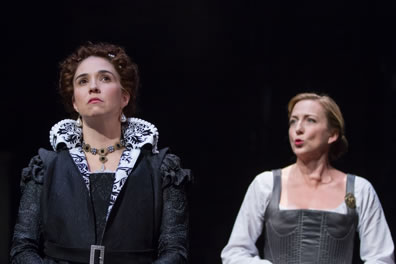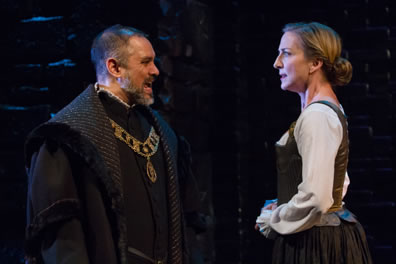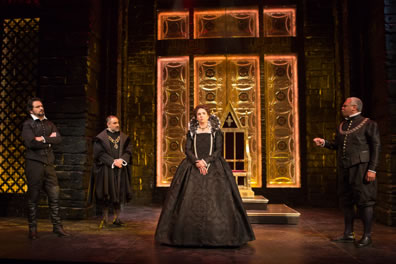Mary Stuart
The Queen of Hearts
By Friedrich Schiller (adapted by Peter Oswald)
Folger Theatre, Washington, D.C.
Sunday, February 1, 2015, G–5&7 (center stalls)
Directed by Richard Clifford

Queen Elizabeth with "proud contempt" (Holly Twyford, left) listens to Mary "glowing with rage, yet noble dignity" (Kate Eastwood Norris) during their one in-person confrontation in the Folger Theatre's production of Friedrich Schiller's Mary Stuart. Photo by Teresa Wood, Folger Shakespeare Library.
I don't like Mary Stuart. I like Friedrich Schiller's play Mary Stuart, deserving of its masterpiece label, and I enjoyed the Folger's current production featuring a who's-who and who's-gonna-be-who-soon cast. I just don't think much of the character of Mary, Queen of Scots, which apparently puts me at odds with both the playwright and his latest translator/adaptor, Peter Oswald, whose version Director Richard Clifford uses for the Folger staging. They seem to consider Mary a heroic martyr with “pride in her heart and Christ in her hand” laying down her life on behalf of traditional values (religious, political, socio-economic). However, my take-away in this the second Mary Stuart I've seen is that at heart it is a play about manhood being snatched out of the claws of feminism.
Which might seem surprising given the actresses playing the rival queens in this fiction based on historical events: Kate Eastwood Norris as Mary, Holly Twyford as Elizabeth. This pairing amounts to a Brady vs. Wilson casting coup in the D.C. theater scene as these two women are among the region's most-awarded female thespians of their generation. Neither has played a queen before, though Norris was a memorable Lady Macbeth at the Folger in 2008 and played Richard III in a 1998 touring production that put both her and the American Shakespeare Center in Staunton, Va., on the map.
“She has extraordinary power over the minds of others; not to mention the judicious use of tears,” Lord Burleigh (Rajesh Bose) says of Mary, and Norris nails this internal director's note for her character. She gives Mary an immense charm that sometimes leaves even her most hard-hearted enemies at a loss for words. Norris infuses Mary with a fervency regarding her Catholic faith and “the laws of all nations,” and she seems determined to always put the best face on every setback and maintain a pleasant demeanor even when arguing that she is a victim of a series of injustices: being imprisoned when she sought sanctuary from her “sister queen,” and being tried and convicted by a court not of her peers (i.e., Queen Elizabeth) but of 42 noblemen. Norris glows in the simple Tudor-era gowns she wears (costumes by Mariah Hale)—Mary doesn't need the jewelry that has been taken from her—and emits a vibrating energy whenever she's on stage. It's no wonder men swoon over her.
It's a performance that masks the inconsistencies in her script. She owns up to her past indescretions—having her royal husband killed and marrying his murderer—and accepts that her own people ran her out of Scotland, yet she blames fate and the evil of others for her current state and keeps stingy hold on her title as queen (queen of what, exactly?). She lays out point by point to Burleigh exactly why she should be considered a threat to Elizabeth, but claims she is innocent of harboring such thoughts (and yet she would be queen of what, exactly?). She writes a letter to Elizabeth asking for a face-to-face meeting and pleads with her jailor Sir Amias Paulet (Louis Butelli) to deliver it, but when he does and the meeting comes to fruition, Mary pleads to be saved “from the detested sight of her” and tries to flee the scene before Elizabeth arrives. Though she all along argues that Queen Elizabeth is her peer, she also argues that Elizabeth, being decreed a bastard by her father, Henry VIII, is not the rightful queen of England, a point she then hammers home to Elizabeth herself in their meeting.
Norris doesn't play to any of these inconsistencies at all, which is a masterful—and disarming—method of getting to the real heart of her character, creating the conundrum that is Mary Stuart. You can't help admiring this woman, and yet a cynic like me (and like Burleigh) can't help feeling that we are being had by a shrewd operator, the kind of woman who uses feminine wiles to cut into the front of the line.
At the front of that line in this case stands Elizabeth. Twyford plays her with a perpetual pout that, in her meeting with Mary, intensifies into the frown of a 6-year-old forced to eat her Brussels sprouts before she can be excused from the table. She is handsome, wearing dark-tone regal gowns that show no shape at all, but the only loveliness she radiates is the gems around her neck and on her fingers. Yet, she is a woman of great wit. Twyford's line readings are so sharp she ambushes us with humor, to the point it is almost a comic role. Engaged in a proxy courtship scene with the King of France through the French ambassador, Bellievre (Todd Scofield), Elizabeth says of her French counterpart that “There is no king in Europe I can think of to whom I would surrender my best treasure with less resistance.” So matter-of-factly does Twyford deliver this backhanded compliment that it generates a ripple of chuckles in the audience. “Hope is beautiful,” Bellievre replies, “but it is something more my master longs for.” “What does he want?” Elizabeth asks, and Twyford zings this across the stage with an expression that wonders if the ambassador himself has been charged with carrying her off to bed then and there, turning chuckles to dialogue-pausing laughter.
For all of Elizabeth's surface demeanor of stoic strength and deliberation, in private moments Twyford lays bare the woman's fears and frustrations, indicating that power is the real prison in this play. We also are allowed to see played out Elizabeth's Machiavellian ways as she maneuvers an outcome in a manner that shunts the blame onto the earnest worker noble-bee Sir William Davison (Scofield again). You can be disgusted by the way she plays Davison (especially in Scofield's wonderful portrayal of a flabbergasted guy who fears he's being set up and yet walks right into the trap anyway); and yet a student of politics like me (and like Burleigh) has to admire the way she guides and protects her nation's independence in the face of a continent of countries seeking her destruction. While I'm not championing her disingenuousness for the trait itself, I do laud her single-minded intent to be a worthy ruler of her people.
Elizabeth's façade breaks in the meeting with Mary (an entirely fictional event), to the point that, upon Mary callling her a bastard, Elizabeth flexes her fingers in a rage that indicates a real catfight is in the offing before the Earls of Shrewsbury (Craig Wallace) and Leicester (Cody Nickell) step between them. The guide to the playing here is in the stage directions: Elizabeth “regards her with a look of proud contempt”; Elizabeth “laughs mockingly”; Mary “glowing with rage, yet with noble dignity”; “Elizabeth, in speechless anger, casts enraged looks at Mary.” I can't help wondering how different this scene might play if these two actresses were using a Shakespearean text in which they could draw on their own intelligence for creating the scene's emotional tenor. Then, Twyford's Elizabeth might not look so uncharacteristically petty in this scene.
Especially as it is Mary who turns characteristically petty at the end of it ("noble dignity"? Yeah, right). Upon Elizabeth departing “with greatest consternation” (according to the stage direction), Mary “still enraged” shouts in triumph, “She leaves in rage! Death in her heart! At last, at last, after years in the dirt, one instant of victory! I feel like a mountain has fallen from my back! I plunged a knife into my enemy's heart!” Her lifelong nurse, Hanna Kennedy (Nancy Robinette), speaks what we all are thinking: “You lost your mind!” But, in fact, Mary is not about the mind. She's all about her heart. That she yowled with more venom to send her rival scurrying away matters more to her than avoiding execution or attaining the crown. In fact, when, immediately after she is given an opportunity to gain freedom, she shrinks from the responsibility. Being the poor, pathetic prisoner is more power in her mind than being a real queen. And for this, Schiller grants her a martyr's death, stoically heading for the chopping block while Elizabeth rules on in misery.

Lord Burleigh (Rajesh Bose) accosts Mary Stuart (Kate Eastwood Norris) in the Folger Theatre's production of Mary Stuart. Burleigh is considered a villain by some critics, but though he is a bully—even toward his own queen—he exhibits a single-minded devotion to serving the state. Photo by Teresa Wood, Folger Shakespeare Library.
Admittedly, it is difficult to gauge this 1800 play's feminism quotient buried in a 21st century adaptation. The theme of male vice female domains is established in the opening scene by the nurse, Hanna, who blames Mary's past indiscretions on “a kind of male recklessness” overcoming her. Hanna hates men. She blames Bothwell and his “horrible male power” for seducing Mary to murder her husband, and she disparages all of Elizabeth's counselors, including the upright Paulet. She even expresses discomfort around Paulet's nephew, Mortimer (Paul-Emile Cendron) even after he has pledged allegiance to Mary (his loyalty is true but, nevertheless, he's kind of creepy, though Mary dotes on his intense adoration of her). The male-female theme is picked up by Elizabeth herself who wonders if a queen, “who does not waste her days in contemplating, doing less than nothing, who tirelessly and uncomplainingly performs the toughest of all duties, should she not be exempt from the natural law that makes one sex the servant of the other?”
By play's end, Elizabeth could be considered the criminal for breaking that “natural law,” while Mary is the hero having remained the weaker vessel all along. But to me, the final scene of Twyford's Elizabeth, sitting alone on her throne having been abandoned by her counselors—those she hadn't already banished—shows us true sacrifice. If Mary couldn't be a queen and live a spoiled life, she'd rather die, whereas Elizabeth gives up all hope of romance and intimate company (and underneath her carefully structured outward bearing, Twyford's Elizabeth yearns for these things) in order for her people to live free. Mary simply doesn't have that kind of moral fortitude.
It's instructive, too, how the men around these two monarchs play archetypes of male domination. Leicester is the cock-centric lothario charming both women (with implications that he also bedded both). His only interest in them is the political power and social status he can attain through them, and if there's some good sex along the way, great. Shrewsbury takes on the role of father figure to both women, as Elizabeth's longtime counselor and Mary's first jailor. He respects both, but nevertheless maintains a somewhat patronizing tone, including toward Elizabeth. When it's clear she is smarter than he, Shrewsbury gives up his post. The young stud Mortimer turns lust at first sight into religious zealotry, elevating Mary to sainthood in his mind and a great object of desire in his other brain (the rescue scene even plays out like a sexual assault).
In Bose's playing, Burleigh is a bulldog of a politician, single-minded in his duty to the state, and he not only bullies Mary but Elizabeth, too—but, then, he bullies everybody, regardless of gender. Some critics label him the play's villain, yet his ego is tied to his service to the state, and in this, he comes across as the least sexist of the counselors. He regards Elizabeth as his queen and the nation's rightful ruler; meanwhile, he regards Mary as a nothing but a threat to the state. His course of advice always falls on the side of strengthening Elizabeth as a ruler—her gender is immaterial to him. Paulet likewise disregards matters of gender, treating Mary merely as his prisoner and Elizabeth merely as his ruler, and he, too, has a strong sense of duty. However, Paulet's duty is to his single-purpose mission.

Queen Elizabeth (Holly Twyford) hears the arguments of her counselors—from left, Leicester (Cody Nickell), Burleigh (Rajesh Bose), and Shrewsbury (Craig Wallace)—in the throne room of Tony Cisek's set for the Folger Theatre's production of Mary Stuart. Photo by Teresa Wood, Folger Shakespeare LIbrary.
For all the focus on the two queens, this production's keenest scene is the verbal tap dance between Burleigh and Paulet, the former suggesting ways Mary could become gravely ill while in Paulet's keep, and Paulet professing (feigning?) misunderstanding before finally denouncing even the mere mention of such a suggestion. “I will let no killer in here!” he says, interrupting Burleigh. “While my household gods protect her, her life is sacred to me—as sacred as the life of the Queen of England.” Bose and Butelli deliver their lines with taut energy, giving the scene a thriller edge and a comic undertow.
Scenic Designer Tony Cisek has built another stunning set for the Folger stage, this a solid backdrop of black bricks and stones representing Paulet's castle where the Queen of Scots and her “blackened” name is “bricked up alive with no comforts.” The wall opens to a golden throne room for Elizabeth's scenes, and this gives way to a misty forest backdrop for the meeting of the two queens. That wall, though, is one of the most animated aspects of this production; the action is mostly static with actors generally standing around speaking passionate words and sometimes clumsy expository dialogue. However, even if this Mary Stuart plays as something of a museum piece, at least we're seeing a cast of Rosetta Stones of the DC acting community—Norris, Twyford, Butelli, Wallace, Nickell, Robinette, and Scofield—giving peak performances. They are equaled in the performances of newcomers Bose with his Burleigh channeling a powerful confidence and Cendron with his Mortimer bursting with irrational passion (if sometimes he seems over-expressive in his worship of Mary, watch how his nerves are tightly wound around his aspect in his scenes of loyalty to Elizabeth).
I come to this play with the experience of being married to a career Air Force officer and commander. She is an Elizabeth insofar as, during her years in the military and continuing service post-retirement, she has maintained a self-sacrificing attitude toward her mission. She also has dealt with her share of Shrewsburys, Leicesters, Burleighs (no villains but some of her finest first sergeants and chiefs), and, thankfully, many Paulets. She's also encountered a few Marys. So maybe that's why I don't share Schiller's (and Oswald's) seeming adoration of the self-centered, irresponsible Mary—or, if I'm reading the playwrights' true intentions wrong, why I see through the character's façade to her truth. But I dare say, England, then and now, are right there with me.
Eric Minton
February 5, 2015
Comment: e-mail editorial@shakespeareances.com
Start a discussion in the Bardroom



 Find additional Shakespeareances
Find additional Shakespeareances